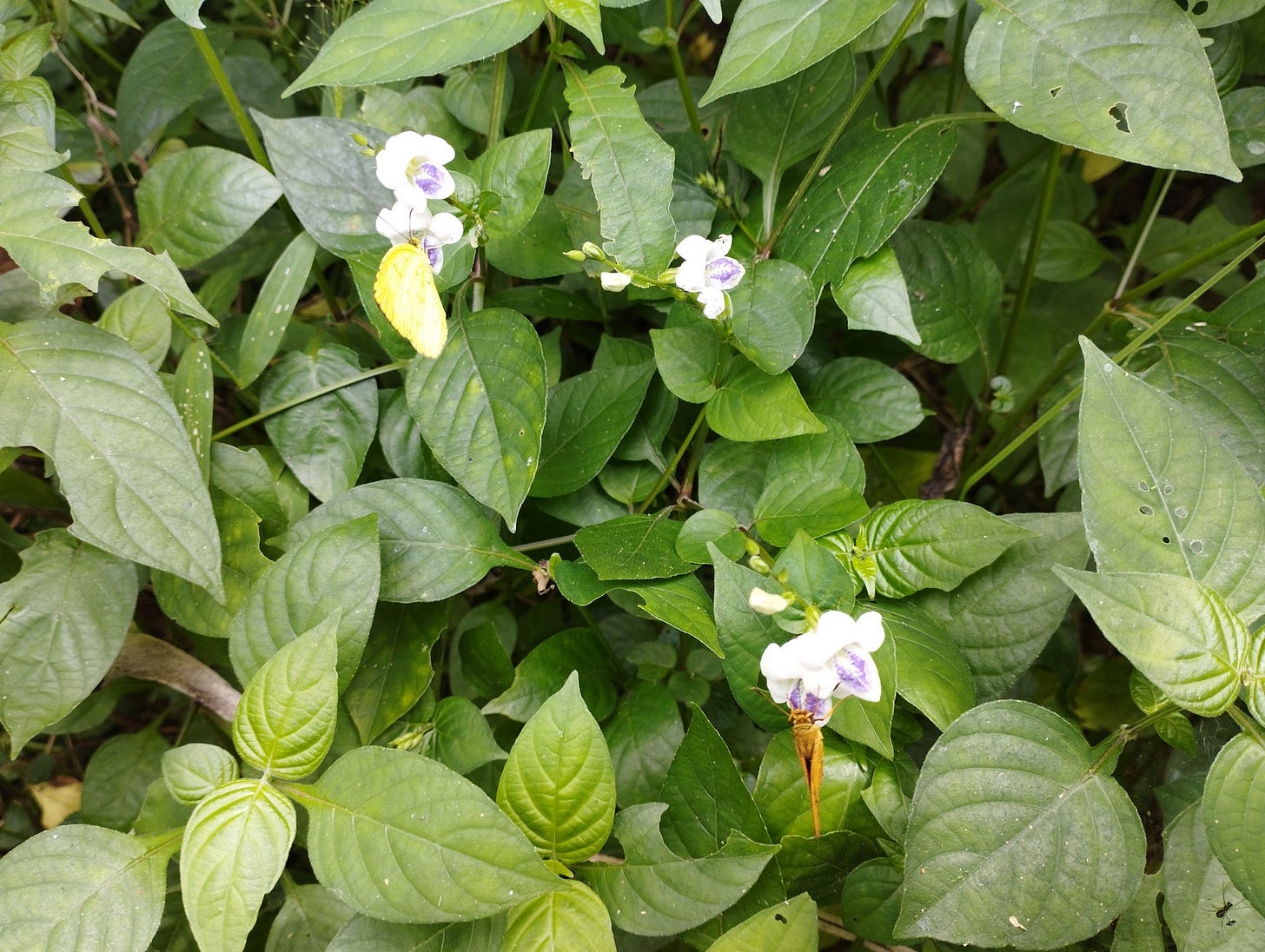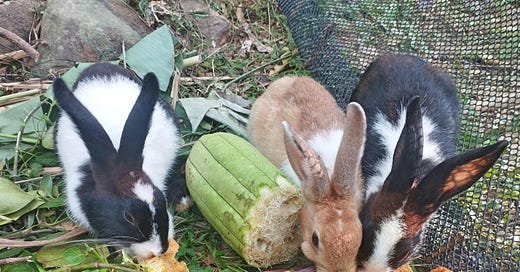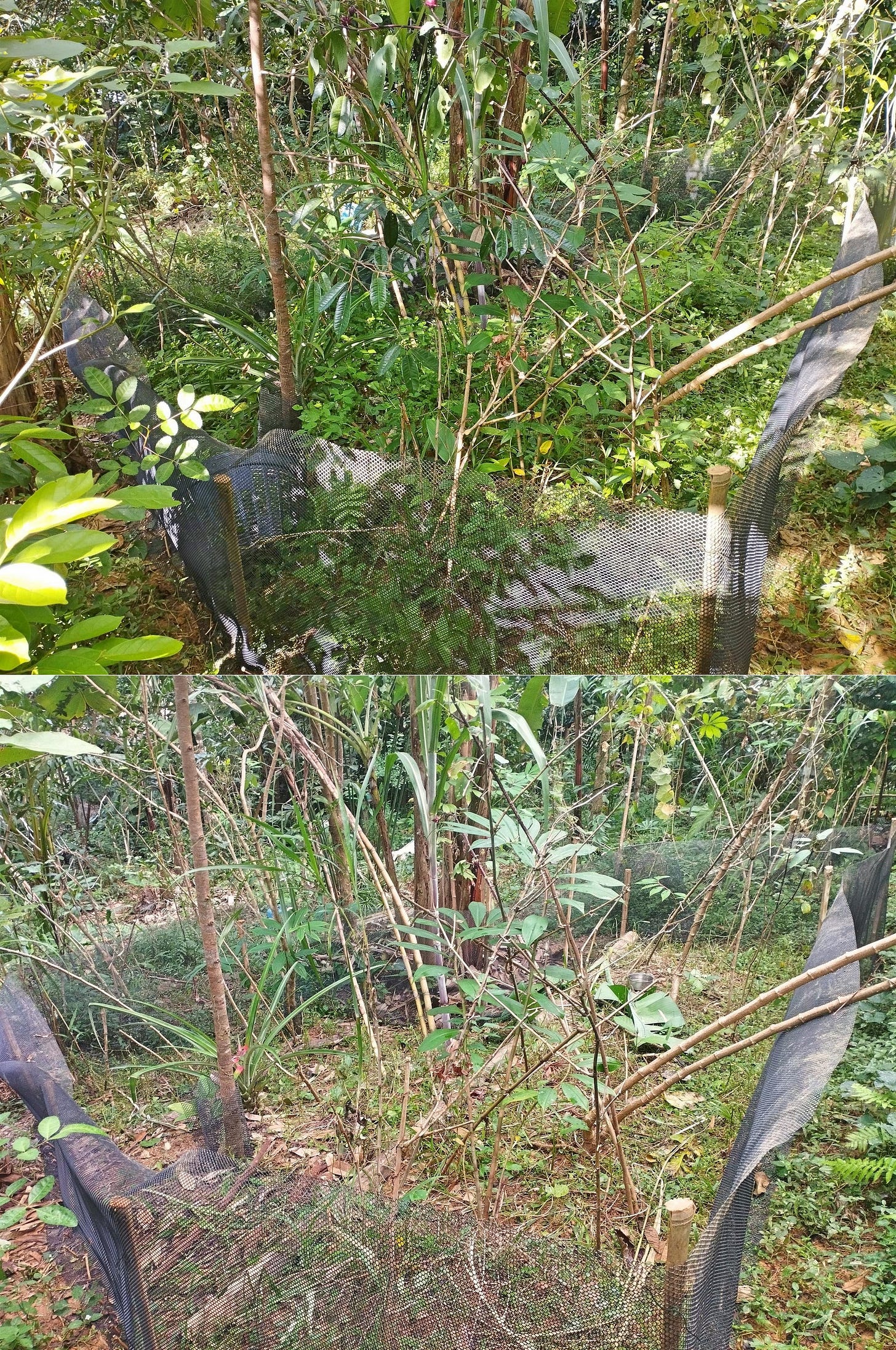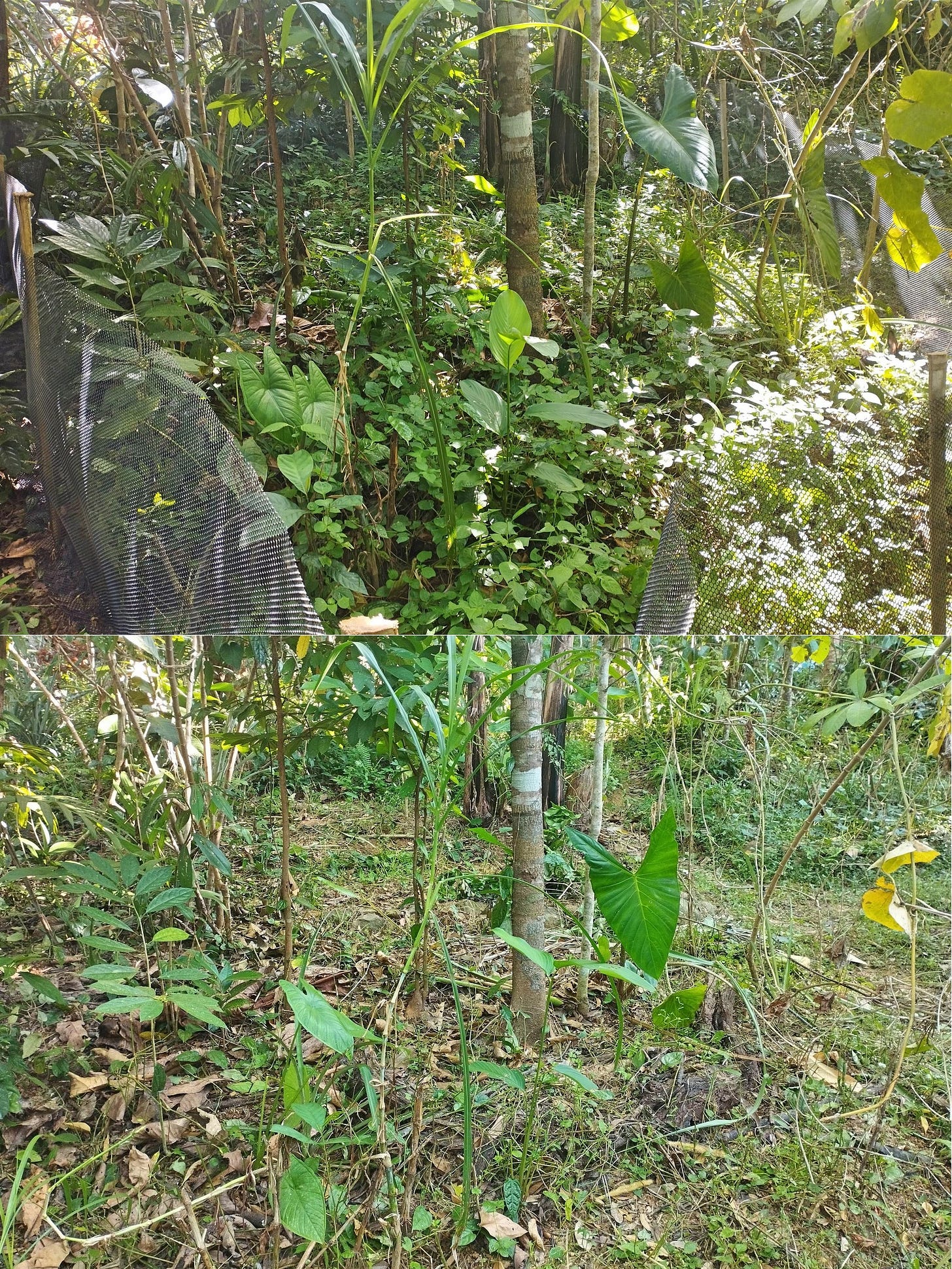The Exhilarating Journey from Grass to Meat (and Shit)
Experiments in small-scale symbiotic animal husbandry --- [Estimated reading time: 15 min.]

Partly because I want to write more about our permaculture & rewilding project (we’ve been rather lazy regarding “content creation” and updates on the garden, and this announcement is long overdue), and partly inspired by Shane’s latest post about his goat herd and his desire to “write something more mundane this week, more personal, less doomerish,” I’m going to tell you about the lovely little beings that have recently joined us here on our land.
For about two months now, we have three little rabbits living with us, the latest addition to our multi-species community: Charlie, Bella, and Cha-mot.1 We bought them spontaneously, a few days after I had to put down one of our beloved cats due to sickness, while we were in desperate need of emotional support. The thought of trying to keep a few rabbits has crossed our minds repeatedly – after watching a short documentary about a rabbit farm in the South of Thailand, we thought it might be worth a try, both to fill an ecological niche that’s thus far uninhabited (small, herbivorous, ground-dwelling mammal) and, ultimately, to diversify our diet. My brother has been keeping a few rabbits in his community over the past year, and they seemed easy enough to take care of (and comparably easy to butcher).
The problem was: where do you find live rabbits, preferably a breed raised for meat? in Thailand, there are places that offer shipping live rabbits via mail (presumably a special courier), but we don’t want to start off with highly traumatized PTSD rabbits. So we had to wait for an opportunity – which finally happened when a woman at the weekly local market sold three young rabbits, apparently because they had “too many at home.” For 100 Baht (less than $3) each, we couldn’t say no.
Just like when we first got our chickens from Karn’s parents’ farm, we got the animals first – a breeding pair – and built their shelter only after we’d acquired them. In the case of the chicken pen, we worked two 10-hour days in the tropical heat to build them an adequate shelter, while they were tied to the kitchen table with a rope. Same with the rabbits: we bought a cheap, temporary cage to house them in until we had finished the new, larger one. So within two days of buying the rabbits, we finished our Rabbit Supermax Prison, build entirely with leftover materials from previous projects.

We keep a cardboard box with two small entrance holes in their cage so that they can satisfy their burrowing instinct and have a place to hide. In the two months since, they’ve added three windows to their simple abode, and I reckon I might have to replace it once the holes become larger than the walls.
In our province we actually have wild rabbits, probably a cross-breed between local species native to Southeast Asia and escaped and consequently naturalized European rabbits, but in the five years we live here we’ve only seen them twice, in a disused rubber plantation next to our land. Our neighbor says they’re fairly common (or at least they used to be), but we suppose that numbers have plummeted in recent years due to habitat loss, pesticide use and overhunting.
A fundamental principle of our interactions with other living beings is to imagine what conditions they would most enjoy to live in (which often means looking at their natural habitat in the wild) and then to recreate those conditions as good as possible. We ask ourselves, “if I would be the tree/herb/chicken/rabbit, what would I need to be happy?” With the chickens, this question is answered rather easily. Like their wild cousins, they desire trees to sleep on, a decent-sized and adequately coherent social group, a wide range of stimuli akin to the ones they would encounter in the forest, thick leaf litter to dig through, a diet rich in insects, grass and fruit, and a cozy place to nest. Easy. For plants, we try to learn how they like to grow in the wild: on acidic, neutral or alkaline soils, in full sun or partial shade, along river banks or on exposed hillsides, or whether they prefer light or heavy soils. We learn their preferred place in the strata of the rainforest, and the plants (and, if the information is available, the fungi) with whom they like to associate.
With our rabbits, we realized that they actually need very few things to be happy: some friends, plenty of grasses, herbs and leafy greens, enough space to run around and play tag, and a small, dark, safe space to hide in. When we bought them in the market, there was no hay or straw in the cage, and they had half an ear of GMO corn and a small bowl filled with foul-smelling pellets to eat. We both have a hard time witnessing animals in conditions that are diametrically opposed to what their Inner Nature desires, so maybe part of the spontaneous decision to buy them was this deeply-felt compassion for mistreated animals.2
But that doesn’t mean we have to “go vegan” and refrain from killing (or at least from killing those beings that most closely resemble ourselves – it is impossible to live without taking lives). If the animals and plants around us are able to live happy and fulfilled lives, we don’t have a problem with ending their lives prematurely in order to feed ourselves. It’s always sad, yes, but that’s the cycle of life, and although the woman who sold us the rabbits was visibly shocked to hear that we plan on slaughtering them (or their offspring) eventually, we have a clear conscience. Up until the very last few seconds, each animal in our garden lived the best life they could ever hope for. We make sure that death comes swift and relatively painlessly, and we always comfort and soothe the animals we kill during their final moments – they don’t die alone.
Local people often comment that they couldn’t bring themselves to butcher domesticated animals, because they “pity” them (สงสาร). This is how alienated life has become in a society that consisted mostly of down-to-earth subsistence farmers just a few decades ago, and how estranged morals and values are in this increasingly disconnected and artificial world. Meat is just another faceless product, a commodity that you buy in the market. Entirely unaware of the irony of eating factory-farmed meat each day (which of course causes immense suffering several orders of magnitude higher than the worst things that animals experience on our farm) while simultaneously claiming virtue for “not causing suffering,” people seem to assume that only the final cut/blow/shot is what bestows “bad karma” upon us. They have a “clean conscience” because they don’t kill the animal themselves – they just buy their meat – and nobody takes responsibility for how the animals are raised and treated. This is hypocrisy at its finest – but it’s well-nigh impossible to argue against it. Religious sensibilities, no matter how ignorant, nonsensical and ludicrous, are better left unchallenged in this country.
But we’ll see what people do once meat becomes prohibitively expensive or unavailable due to supply chain issues and other imminent problems faced by the meat industry. Let’s hope we have enough rabbits to share with our neighbors by then.
As soon as we got them home, the rabbits seemed extremely curios about their new environment – so calm and serene compared to the dusty concrete desert of the busy market town, and with food growing literally everywhere!
The very first thing we noticed: the rabbits go absolutely bonkers for grasses and certain tree leaves. I think I’ve never seen animals this easily excited by the smallest and most easily overlooked plants, and it is such a delight to watch them devour leaf after leaf, blade after blade – a never ending stream of vegetation disappearing in their busily munching jaws, instantly converted into an equally unabating output of pellet-shaped droppings. Often, when we bring them another handful of grass to the door of their Supermax prison (maybe I should start thinking about a better term?), they get so excited that they start chasing each other in a narrow circle right in front of the door – a rapidly rotating swirl of cuteness.
Curiously enough, of all the dozens of plants we feed them, they seemingly always prefer cannabis leaves. It is their favorite food by a large margin, so the fan leaves we trim off our plants are now a special treat for the rabbits, and only occasionally a food ingredient for us.
We also feed them bananas, guavas, jackfruit, chempedak, June plum and other fruits – if available – which they seem to love almost as much as our weed trimmings. They also eat large quantities of the freshly shredded banana leaves that we use as bedding in their Supermax facility. We use about two to four leaves per day, and it seems that the next morning there’s only half that amount left. The rabbits are eating basically nonstop, and even when I leave the house to relieve myself in the middle of the night, they are always awake and return my gaze, their eyes reflecting the glare of my headlamp, a sliver of banana leaf disappearing into their tiny mouths. Diligent, lovely little beings.

As we transition into dry season, their favorite staple food, Asystasia gangetica micrantha (commonly known as Chinese violet or หญ้าบาหยา – yâa baa-yăa – in Thai) is getting harder and harder to find. We have started feeding them more tree leaves, especially hibiscus, Carallia brachiata (มั่งมี –mâng mee) and Archidendron quocense (หย่อง – yòng), although they eat a large variety of other tree foliage as well. Even plants that contain considerable quantities of calcium oxalate (which make them unfit for human consumption when raw, like a common edible wild species in the Araceae family) are occasionally nibbled, and while we were initially very careful with what to feed them (a friend once accidentally killed a bunch of rabbits by feeding them cassava leaves – much to the dismay of his daughters), the past months have shown that their instincts are reliable. They simply don’t touch some plants, like the common medicinal herb Siam weed (Chromolaena odorata) for instance – plants that are presumably not delicious enough, or that might even be toxic. Another favorite staple is sweet potato leaves, which we feed to them each day. The last two enclosures were old vegetable beds waiting for the annual re-digging, and we planted sweet potatoes as a cover crop and to use the young shoots as a vegetable.3 They even eat surprising quantities of tough pineapple leaves!
The list of daily tasks is a bit longer now: every day, we have to move the rabbits to their current enclosure and back, bring them a few handfuls of grass, herbs and branches as additional food, and cut a few banana leaves to add to the cage each day, both as bedding and as food. The accumulated banana leaf shreds are cleared out about once or twice a week, and the resulting substrate is an ideal – no, a perfect mulch for our vegetable beds: compared to leaf litter (devoured by termites in no time) and chopped Napier grass (lacking in permeability and durability), shredded banana leaves mixed with rabbit shit seems the best choice by a wide margin. And the vegetables love the additional fertilizer.
Animal dung (our own “humanure” included) is one of the basic resources we require in greater quantities than we currently produce, so we buy a few bags of dry cow shit about once every two or three months. Chicken shit is found in abundance in their coop, but it is not easily collected. We wait until the chicken shit has mixed with the decomposing leaf litter we constantly add to the chicken pen, and once per year – at the onset of rainy season – we mine the black, fertile soil that has accumulated on the downslope side of the enclosure.4
The thing I love the most about our rabbits is the fact that they make us laugh out loud with joy several times per day – each time we bring them a new bundle of grasses and herbs. Seeing the excitement and joy of our furry friends at the mere opportunity to eat those humblest of foods exhilarates me every single time. Truly uplifting.
They come running excitedly each time we go near their current enclosure, and seem to be keenly aware of where in the garden we humans are at any moment. Often, we observe them from further away, racing each other, or standing on their hind legs and sniffing the wind. Smelling seems to be one of their dominant senses, maybe even more than eyesight. But even when we place a few pieces of banana on the ground that they could smell before we even started peeling it – they become so animated that they scurry clumsily all over the place, repeatedly jumping a bit too far into the direction from which the delicious, sweet scent comes, confusingly sniffing left and right before doubling back to try again.
I have also noticed that I perceive and assess the garden in a whole new way. I pay much more attention to inconspicuous grasses and herbs than ever before. Patches with lush grass stand out and catch my attention now, I make mental notes about the specific conditions in that spot, and remember places with abundant stands of delicacies to harvest for the rabbits later on. Several dozen varieties of grasses and herbs now have a new meaning, a new purpose, beyond just being materials to mulch, compost, and (in some cases) to occasionally eat or make tea from. They are now also rabbit food, to be converted into organic fertilizer pellets and meat protein.
We move the small herd around in a miniature version of MIRG (management-intensive rotational grazing), moving them to new pasture about once per week – depending on the size of the area. Fencing a new area even feels a tiny bit like being a rancher/cowboy, since this is a task that’s completely novel for both of us and always reminds us of the “Wild West” – what we’re doing feels basically a miniature version of it, just without the horses and guns.
We use a role of plastic mesh, bamboo fence posts, and “bamboo nails” (~15cm branch cuttings) to fix the mesh to the ground. The entire fence takes half an hour to take down and another half hour to re-erect elsewhere.

People with experience in the “Rabbit Biz” warned us that they will start digging holes under the fence and try to escape frequently, but with our current moving schedule it seems like this will not be a problem, at least not now. Rainy season will be a real challenge, but if we manage to build another Supermax facility (for when they have offspring), it should be doable. The rabbits will just have to spend more time under a roof, just like us and the chickens, but there will be as much fresh grass as they desire.
Concluding, I have a really good feeling about the whole project. Apart from having to worry a bit about snakes, dogs,5 and humidity-related disease, keeping rabbits seems like a walk in the park. It’s more work for us, sure, but the work is enjoyable and highly rewarding. The rabbits seem content enough, and fit perfectly into our emerging ecosystem, all the while making themselves useful as “walking compost heaps” and natural lawnmowers. We still haven’t figured out who is male and who is female – I looked at a disturbing amount of rabbit genitalia photographs online, but am still unable to determine their sex – but there is no rush. We will find out soon enough, and if we end up with three males or three females, the women from the market has already confirmed that we might be able to get more young rabbits from her in the future. To ensure strong genetics for the following generations, we will have to keep our eyes open for other rabbit breeders in the area anyway.
Now, let’s see when we get the first round of baby rabbits! If they breed as fast as everybody is saying, we might eat rabbit stew more often than grilled chicken in the not-too-distant future!
I write stuff like the above in my free time, when I’m not tending the piece of land we’re rewilding here at Feun Foo. As a subsistence farmer by profession I don’t have a regular income, so if you have a few bucks to spare please consider supporting my work with a small donation:
If you want to support our project on a regular basis, you can become a Patron for as little as $1 per month - cheaper than a paid subscription!
Chá-mót (ชะมด) is the Thai name of the Asian palm civet – the small nocturnal mammal that (in)famously eats coffee cherries and shits out the beans. People collect their droppings to make “civet shit coffee” for rich people to drink. We are currently processing coffee, and Cha-mot really loves the coffee cherry flesh we feed them occasionally.
There is a store in the small market town that has a large scarlet macaw and an Asian leopard cat on display (presumably as status symbols to brag how rich they are), both in iron shackles. It’s difficult to witness things like this without being able to do anything about it.
Our soil is not good enough yet to yield large sweet potatoes, and we will need to carry a lot more sand up from the pond to improve the texture. When we re-dig vegetable beds we always find a few bright purple potatoes, but there’s usually only enough for a side dish or snack.
We thought about doing rotational grazing with the chickens as well, but soon after decided that it would simply be too much work to move the fence around each month. Most of our chickens are Ayam Kampong, a semi-wild breed that can easily fly over fences that are three meters high, but we have one hen that looks like the fat brown chicken my grandparents used to keep – people call this common domesticated breed ไก่ไข่ (“the chicken that lays eggs”) in Thai. The “regular” chicken’s offspring (almost half the flock by now) are a hybrid, who are nonetheless excellent aviators. Every day we let them roam free in the upper part of the land for a few hours, but when we take a bit too long to open the door in the morning, they straightforwardly take the freedom that’s rightfully theirs. Each late morning and afternoon, the chicken climb the durian tree that grows in the pen and, one after the other, simply fly over the fence. Then they start foraging, slowly moving downhill, and when they get closer to the house (where all those interesting-looking vegetable beds with the deep mulch and the borders planted in crunchy watercress are) we chase them back up and feed them a small cupful of rice – basically a tribute payment for not raiding us.
We were initially worried about whether our cats would chase and kill the rabbits, but so far the cats have met their new roomies with disinterest bordering on contempt. We’re still working on facilitating their friendship: when we (occasionally) place the cats in the enclosure, the rabbits are keen to sniff them – which the cats hate so much that they run away, a pained expression on their faces.













I am really, really enjoying my rabbit raising project and I am so glad you are too. One of the big reasons why is precisely as you said - it seems relatively easy to meet their requirements for a very pleasant existence.
9 out of 10 people I meet respond the same as the locals you mention, who "comment that they couldn’t bring themselves to butcher domesticated animals, because they “pity” them." I raise chickens as well and most people never say such a thing in response to the birds. But the rabbits because they are "cute" bring out this hypocrisy in the extreme. I always respond with "Oh. Are you a vegetarian?" and they always say "No" but that they prefer to get their meat at the store. And I say something like "Oh, you prefer it when they are tortured first with horrible lives?" Lol It would be annoying if I didn't truly enjoy the silver lining of making people examine their embarrassing hypocrisy. But yes there is definite taboo about rabbit meat here. And people dont seem to understand its a domesticated meat source. They think it will be "game-y" with stringy, sparse meat...
I anticipate that the ease of care, relatively low and economical energy inputs for feed, small space requirements and valuable utility as fertilizer producers is going to make rabbit meat popular in the coming years as the polycrisis continues. I think it's smart to be getting ahead of the game now!
Really excited to hear more! We have a lot of wild rabbits - I'm excited to see how this goes as I've always been intrigued by keeping rabbits. I'd love to learn about your chicken coop work as well
I got really good results with sweet potatoes by soaking it in a slurry of forest soil + water (just massage it to release the organisms into the water). I soaked the leaves for 15 minutes - I got nearly double the yield by soaking it.